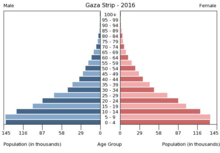
The demographics of Israel, monitored by the Israel Central Bureau of Statistics, encompass various attributes that define the nation's populace. Since its establishment in 1948, Israel has witnessed significant changes in its demographics. Formed as a homeland for the Jewish people, Israel has attracted Jewish immigrants from Europe, Asia, Africa, and the Americas.

Jordan has a population of more than 11.1 million inhabitants as of 2023. Jordanians are the citizens of Jordan. Around 94% of Jordanians are Arabs, while the remaining 6% belong to other ethnic minorities, including Circassians, Chechens, Armenians and Kurds. Around 2.9 million inhabitants are non-citizens, a figure including refugees, legal and illegal immigrants. Jordan's annual population growth rate stands at 3.05% as of 2023, with an average birth rate of 2.8. There were 1,977,534 households in Jordan in 2015, with an average of 4.8 persons per household.

Palestinians or Palestinian people, also referred to as Palestinian Arabs, are an ethnonational group descending from peoples who have inhabited the region of Palestine over the millennia, and who today are culturally and linguistically Arab.

The West Bank, so called due to its relation to the Jordan River, is the larger of the two Palestinian territories. A landlocked territory near the coast of the Mediterranean Sea in the Levant region of West Asia, it is bordered by Jordan and the Dead Sea to the east and by Israel to the south, west, and north. The territory has been under Israeli occupation since 1967.

The Palestinian territories are the two regions of the former British Mandate for Palestine that have been occupied by Israel since the Six-Day War of 1967, namely the West Bank and the Gaza Strip. The International Court of Justice (ICJ) has referred to the West Bank, including East Jerusalem, as "the Occupied Palestinian Territory", and this term was used as the legal definition by the ICJ in its advisory opinion of July 2004. The term occupied Palestinian territory was used by the United Nations and other international organizations between October 1999 and December 2012 to refer to areas controlled by the Palestinian National Authority, but from 2012, when Palestine was admitted as one of its non-member observer states, the United Nations started using exclusively the name State of Palestine. The European Union (EU) also uses the term "occupied Palestinian territory". The government of Israel and its supporters use the label "disputed territories" instead.

Palestine, officially the State of Palestine, is a country in the Southern Levant region of West Asia. It comprises of two disconnected regions – the West Bank and the Gaza Strip. It shares borders with Israel to the west and north, Jordan to the east and Egypt to the southwest. Palestine's combined land area is 6,020 square kilometres (2,320 sq mi) while its population exceeds five million people. Its proclaimed capital is Jerusalem while Rafah is the largest city and Ramallah serves as the administrative center. The official language is Arabic. The majority of Palestinians practice Islam while Christianity also has a significant presence.
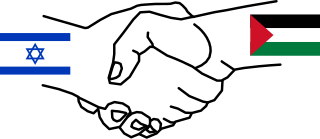
The one-state solution is a proposed approach to resolving the Israeli–Palestinian conflict, according to which one state would be established between the River Jordan and the Mediterranean. Proponents of this solution advocate a single state encompassing the currently recognized state of Israel, the West Bank and the Gaza Strip. The term one-state reality describes the belief that the current situation in Israel/Palestine is de facto a single state. The one-state solution is sometimes also called a bi-national state, owing to the hope that the state would be a homeland for both Jews and Palestinians.

Rafah is a Palestinian city in the southern Gaza Strip. It is the capital of the Rafah Governorate of the State of Palestine, located 30 kilometers (19 mi) south-west of Gaza City. In 2017, Rafah had a population of 171,889. As a result of massive bombardment and ground assaults in Gaza City and Khan Yunis by Israel during the Israel–Hamas war, about 1.4 million people are believed to be sheltering in Rafah as of February 2024.

The population statistics for Israeli settlements in the West Bank are collected by the Israel Central Bureau of Statistics. As such, the data contains only population of settlements recognized by the Israeli authorities. Israeli outposts, which are illegal by Israeli law, are not tracked, and their population is hard to establish. All settlements in the West Bank were advised by the International Court of Justice to be unlawful.

Qalqilya or Qalqiliya is a Palestinian city in the West Bank which serves as the administrative center of the Qalqilya Governorate of the State of Palestine. In the 2017 census, the city had a population of 51,683. Qalqilya is surrounded by the Israeli West Bank wall, with a narrow gap in the east controlled by the Israeli military and a tunnel to the Palestinian town of Hableh. Qalqilya is under the administration of the Palestinian National Authority, while remaining under Israeli military occupation. Oranges are a major part of the city's economy.
The population of the region of Palestine, which approximately corresponds to modern Israel and the Palestinian territories, has varied in both size and ethnic composition throughout the history of Palestine.
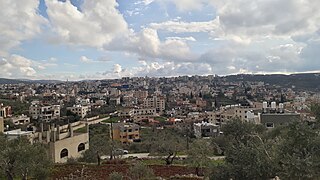
Salfit is a Palestinian city in the central West Bank, and the capital of the Salfit Governorate of the State of Palestine. Salfit is located at an altitude of 570 meters (1,870 ft), adjacent to the Israeli settlement of Ariel. According to the Palestinian Central Bureau of Statistics (PCBS), Salfit had a population of 10,911 in 2017. Since the 1995 Interim Agreement on the West Bank and the Gaza Strip, Salfit, located in Area A, has been administered by the Palestinian National Authority, while continuing under Israeli military occupation.

'Atara is a Palestinian village in the Ramallah and al-Bireh Governorate, located 15 kilometers north of Ramallah in the central West Bank. It is situated along a mountain ridge line with four peaks and is built upon the second highest point in the West Bank at 810 meters above sea level. 'Atara's total land area consists of 9,545 dunams, most of which is cultivable.
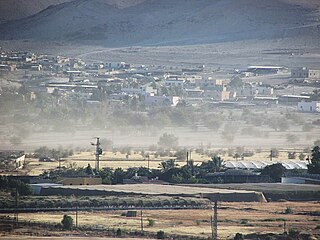
Fasayil or Fasa'il, ancient Phasaelis, is a Palestinian village in the northeastern West Bank, a part of the Jericho Governorate, located 14 kilometres (8.7 mi) northwest of Jericho and about 40 kilometres (25 mi) southeast of Nablus. The closest Palestinian locality is Duma to the west. The village is located 2 km south of the Israeli settlement of Petza'el. According to the 2017 census by the Palestinian Central Bureau of Statistics (PCBS), the village had a population of 1,637.

An-Naqura is a Palestinian village in the Nablus Governorate in northern West Bank, located 10 kilometers northwest of Nablus and adjacent to the Israeli settlement of Shavei Shomron. According to the Palestinian Central Bureau of Statistics (PCBS) census, the village had a population of 1,545 in 2007 and 1,786 in 2017. An-Naqura is administered by a ten-member village council headed by Muhammad Hashish.

Kufeirit is a Palestinian village in the West Bank, located 16 km west of the city of Jenin in the northern West Bank. According to the Palestinian Central Bureau of Statistics, the town had a population of 2,446 inhabitants in mid-year 2006 and 3,068 by 2017.
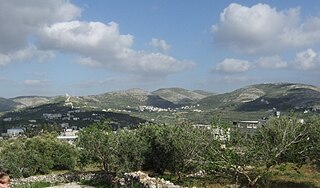
Ijnisinya is a Palestinian village located six kilometres northwest of Nablus in the Nablus Governorate. Most of the working-age inhabitants live as farmers or governmental workers. It had a population of about 585 in 2017. Ijnisinya is governed by a village council.
People of the Palestinian territories—the West Bank and the Gaza Strip—are bound by differing laws that handle marital unions on the basis of the couple's national status and religious affiliation. After the 1948 Arab–Israeli War, the Palestinian residents of the Jordanian-annexed West Bank and the Egyptian-occupied Gaza Strip became subject to Jordanian marriage law and Egyptian marriage law, respectively. After the 1967 Arab–Israeli War, which saw Israel capture the Palestinian territories from Jordan and Egypt, those original laws largely remained in place.
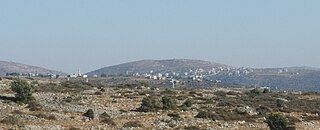
Ammuriya is a Palestinian village in the Nablus Governorate of the State of Palestine in the northern West Bank, located south of Nablus. According to the Palestinian Central Bureau of Statistics (PCBS) census, Ammuriya had a population of 371 in 2017. There were 48 households and five business establishments in the village.




